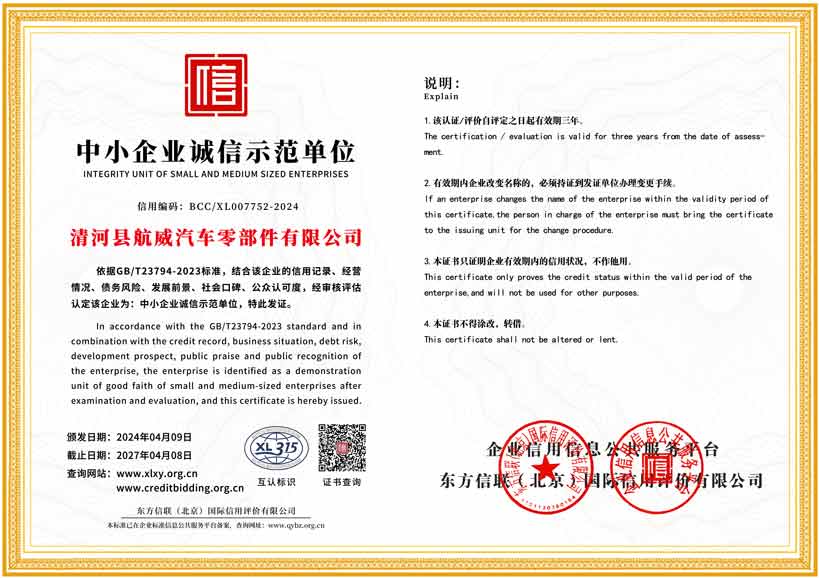Connection from Clutch Line to Slave Cylinder in Automotive Systems
Understanding Clutch Line to Slave Cylinder A Crucial Component in Automotive Systems
The functioning of a vehicle's manual transmission system revolves around several integral components working in harmony. Among these, the clutch line and the slave cylinder play pivotal roles in ensuring smooth gear shifts and overall driving comfort. Understanding the connection and function of the clutch line to the slave cylinder can help vehicle owners maintain and troubleshoot their systems effectively.
What is the Clutch Line?
The clutch line is a hydraulic line that connects the master cylinder—located near the clutch pedal—to the slave cylinder, which is typically situated near the transmission. This line is essential in transmitting hydraulic pressure from the master cylinder to the slave cylinder when the driver presses the clutch pedal. The hydraulic system operates under Pascal’s principle, meaning that when pressure is applied to the fluid in a confined space, it is transmitted equally in all directions.
Functionality of the Clutch Line
When the driver depresses the clutch pedal, the master cylinder compresses the hydraulic fluid within the clutch line. This pressure surge travels through the line to the slave cylinder, forcing it to engage or disengage the clutch. This process effectively disconnects the engine from the transmission, allowing for smooth gear changes without stalling the engine. The entire mechanism relies on the integrity of the clutch line—if it is damaged or worn out, it can lead to significant performance issues, including difficulty in shifting gears or complete failure of the clutch system.
The Role of the Slave Cylinder
The slave cylinder, a small hydraulic piston, receives the hydraulic fluid from the clutch line and converts that hydraulic pressure into mechanical movement. This movement pushes the release fork, which then disengages the clutch disc from the flywheel. This action is critical for managing the torque transfer from the engine to the transmission, thus enabling the driver to shift gears seamlessly.
Common Issues with Clutch Lines and Slave Cylinders
Over time, several issues can arise with the clutch line and slave cylinder, primarily due to wear and tear, environmental factors, or lack of maintenance. Here are some common problems
clutch line to slave cylinder

1. Leaking Clutch Line If the clutch line develops a leak, hydraulic fluid can escape, leading to a decrease in pressure. Without adequate pressure, the slave cylinder won’t function effectively, resulting in a dragging clutch or difficulty in engaging gears.
2. Clogged Clutch Line Dirt and debris can accumulate within the clutch line, hindering the flow of hydraulic fluid. This blockage can lead to a spongy feel in the clutch pedal or difficulty in shifting gears.
3. Slave Cylinder Failure Signs of failure in the slave cylinder include fluid leaks around the cylinder and an inability to fully disengage the clutch. This problem can cause gear grinding and increased wear on the transmission, leading to expensive repairs.
Maintenance Tips
To ensure the clutch line and slave cylinder operate efficiently, regular maintenance is crucial. Here are some tips for vehicle owners
- Regular Inspection Periodically check the clutch line for any signs of wear, such as cracks or leaks. Similarly, inspect the slave cylinder for any fluid leaks or unusual signs of corrosion.
- Hydraulic Fluid Replacement The hydraulic fluid should be replaced according to the vehicle manufacturer’s guidelines. Old or contaminated fluid can lead to corrosion and reduce the overall efficiency of the hydraulic system.
- Professional Assistance If you notice any issues with the clutch engagement or pedal feel, it’s essential to have a professional mechanic examine the system. Early diagnosis can prevent more severe problems down the line.
Conclusion
In summary, the clutch line and slave cylinder are critical components of a vehicle's manual transmission system, working in tandem to facilitate smooth gear shifts. Understanding their functionality and common issues can empower vehicle owners to perform preventive maintenance and seek professional help when necessary. By doing so, drivers can enhance the longevity of their vehicle's transmission and ensure a reliable driving experience. Remember, simple preventive measures can save significant repair costs and maintain optimal performance on the road.
-
Upgrade Your Vehicle with High-Quality Handbrake CablesNewsNov.01,2024
-
Optimize Your Bike's Performance with Quality CablesNewsNov.01,2024
-
Enhance Your Vehicle's Performance with Quality Clutch ComponentsNewsNov.01,2024
-
Elevate Your Vehicle's Performance with Quality Throttle CablesNewsNov.01,2024
-
Elevate Your Vehicle's Performance with Quality CablesNewsNov.01,2024
-
Affordable Solutions for Your Cable NeedsNewsNov.01,2024
